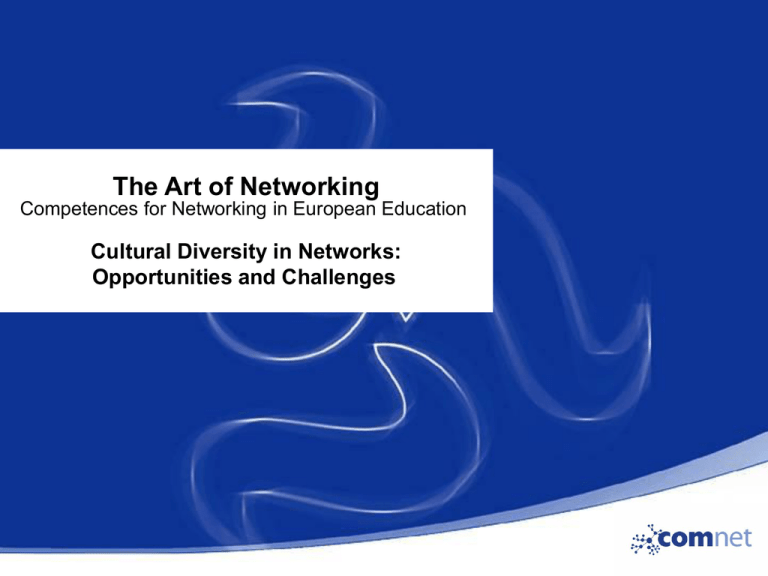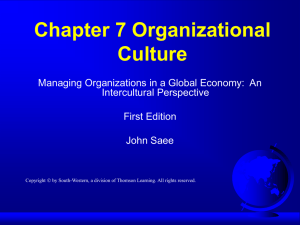culture
advertisement

The Art of Networking Competences for Networking in European Education Cultural Diversity in Networks: Opportunities and Challenges Intercultural Aspects of Networking In (inter-)national networks people from various cultural backgrounds work together Managing a network – in particular a European Network – requires awareness about cultural differences! How do cultures differ and how does this affect networking? The Iceberg Model of Culture What is Culture? The word culture, from the Latin colo, -ere, with its root meaning "to cultivate“. Culture can be defined as the way of life of a society. As such, it includes codes of manners, dress, language, religion, rituals, norms of behaviors, systems of belief etc. Cultural Diversity Cultural diversity does not only exist between different nations, but also between people of a different: – – – – – – Age Gender Work style Educational Status Physical Ability Etc. Gardenswartz & Rowe: „The Layers of Diversity“ Diversity Management „The concept of recognizing the wide variety of qualities possessed by people within an organization. It emphasizes the individuality of people, and the importance of valuing each person for his or her unique combination of skills, competences, attributes, knowledge, personality traits, etc.“ Heery E. & Noon, M. (2001) Intercultural Communication Cultural Differences Cultural differences can be described using different theoretical concepts, such as: – Cultural Dimensions by Geert Hofstede – Cultural Dimensions by Fons Trompenaars – High and low context cultures by Edward T. Hall Cultural Dimensions by Hofstede Low vs. High Power Distance (the extent to which the less powerful members of institutions and organizations expect and accept that power is distributed unequally) Individualism vs. Collectivism (the extent to which people are expected to stand up for themselves and to choose their own affiliations, or alternatively act predominantly as a member of a lifelong group or organization) Masculinity vs. Femininity (the value placed on traditionally male or female values, as understood in most Western cultures) Uncertainty Avoidance (the extent to which members of a society attempt to cope with anxiety by minimizing uncertainty) Long vs. Short-term Orientation (a society's "time horizon," or the importance attached to the future versus the past and present) Cultural Dimensions by Trompenaars Universalism vs. Particularism (What is more important, rules or relationships?) Individualism vs. Collectivism (Do we function in a group or as individuals?) Neutral vs. Emotional (Do we display our emotions?) Specific vs. Diffuse (Is responsibility specifically assigned or diffusely accepted?) Achievement vs. Ascription (Do we have to prove ourselves to receive status or is it given to us?) Sequential vs. Synchronic (Do we do things one at a time or several things at once?) Internal vs. External Control (Do we control our environment or are we controlled by it?) Beyond Culture by Edward T. Hall High context cultures (societies or groups where people have close connections over a long period of time. Many aspects of cultural behavior are not made explicit because most members know what to do and what to think from years of interaction with each other) Low context cultures (societies where people tend to have many connections but of shorter duration or for some specific reason. In these societies, cultural behavior and beliefs may need to be spelled out explicitly so that those coming into the cultural environment know how to behave) Critical Incidents Work on examples which could be faced in networks: 1. Go through the cases individually! 2. Choose your answers and put your dots on the board! 3. Discuss your answers! • There are no right or wrong answers! Final discussion Parallels to your professional life / experience with networks: > Have you ever faced similar situations in your professional life? > How do you think can cultural differences influence networks? > How can we be prepared when being confronted with cultural differences?











